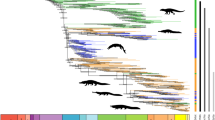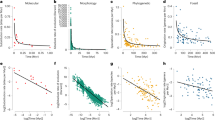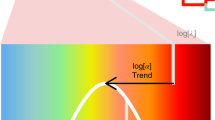Abstract
The dynamics of extinction and diversification determine the long-term effects of extinction episodes1. If rapid bursts of extinction are offset by equally rapid bursts of diversification, their biodiversity consequences will be transient. But if diversification rates cannot accelerate rapidly enough, pulses of extinction will lead to long-lasting depletion of biodiversity2,3. Here I use spectral analysis of the fossil record to test whether diversification rates can accelerate as much as extinction rates, over both short and long spans of geological time. I show that although the long-wavelength variability of diversification rates equals or exceeds that of extinctions, diversification rates are markedly less variable than extinction rates at wavelengths shorter than roughly 25 million years. This implies that there are intrinsic speed limits that constrain how rapidly diversification rates can accelerate in response to pulses of extinction.
This is a preview of subscription content, access via your institution
Access options
Subscribe to this journal
Receive 51 print issues and online access
$199.00 per year
only $3.90 per issue
Buy this article
- Purchase on Springer Link
- Instant access to full article PDF
Prices may be subject to local taxes which are calculated during checkout


Similar content being viewed by others
References
Erwin, D. H. The end and the beginning: recoveries from mass extinctions. Trends Ecol. Evol. 13, 344–349 (1998).
Stanley, S. M. Delayed recovery and the spacing of major extinctions. Paleobiology 16, 401–414 (1990).
Myers, N. & Knoll, A. H. The biotic crisis and the future of evolution. Proc. Natl Acad. Sci. USA 98, 5389–5392 (2001).
Foster, G. Time series analysis by projection. 1. Statistical properties of Fourier analysis. Astron. J. 111, 541–554 (1996).
Scargle, J. D. Studies in astronomical time series analysis. II. Statistical aspects of spectral analysis of unevenly spaced data. Astrophys. J. 263, 835–853 (1982).
Sepkoski, J. J. Jr Ten years in the library: new data confirm paleontological patterns. Paleobiology 19, 43–51 (1993).
Sepkoski, J. J. Jr in Global Events and Event Stratigraphy in the Phanerozoic (ed. Walliser, O. H.) 35–51 (Springer, Berlin, 1996).
Gilinsky, N. L. in Analytical Paleobiology (eds Gilinsky, N. L. & Signor, P. W.) 157–174 (The Paleontological Society, Knoxville, Tennessee, 1991).
Foote, M. Temporal variation in extinction risk and temporal scaling of extinction metrics. Paleobiology 20, 424–444 (1994).
Newell, N. D. Revolutions in the history of life. Geol. Soc. Am. Special Paper 89, 63–91 (1967).
Smith, A. B. Large-scale heterogeneity of the fossil record: implications for Phanerozoic biodiversity studies. Phil. Trans. R. Soc. Lond. B 356, 351–367 (2001).
Foote, M. Origination and extinction components of taxonomic diversity: general problems. Paleobiology 26 (Suppl.), 74–102 (2000).
Jablonski, D. Geographic variation in the molluscan recovery from the end-Cretaceous extinction. Science 279, 1327–1330 (1998).
Miller, A. I. Biotic transitions in global marine diversity. Science 281, 1157–1160 (1998).
Raup, D. M. Large-body impact and extinction in the Phanerozoic. Paleobiology 18, 80–88 (1992).
Kirchner, J. W. & Weil, A. Delayed biological recovery from extinctions throughout the fossil record. Nature 404, 177–180 (2000).
Erwin, D. H. Lessons from the past: Biotic recoveries from mass extinctions. Proc. Natl Acad. Sci. USA 98, 5399–5403 (2001).
Foote, M. Origination and extinction components of taxonomic diversity: Paleozoic and post-Paleozoic dynamics. Paleobiology 26, 578–605 (2000).
Pimm, S. L., Russell, G. J., Gittleman, G. L. & Brooks, T. M. The future of biodiversity. Science 269, 347–354 (1995).
Ehrlich, P. R. & Wilson, E. O. Biodiversity studies: science and policy. Science 253, 758–762 (1991).
Wilson, E. O. The Diversity of Life (Norton, New York, 1999).
Jablonski, D. in Extinction Rates (eds Lawton, J. H. & May, R. M.) 25–44 (Oxford Univ. Press, New York, 1995).
Jablonski, D. Lessons from the past: Evolutionary impacts of mass extinctions. Proc. Natl Acad. Sci. USA 98, 5393–5398 (2001).
Schulz, M. & Stattegger, K. SPECTRUM: Spectral analysis of unevenly spaced paleoclimatic time series. Comput. Geosci. 23, 929–945 (1997).
Kirchner, J. W. & Weil, A. No fractals in fossil extinction statistics. Nature 395, 337–338 (1998).
Cartwright, M. Fourier Methods for Mathematicians, Scientists, and Engineers (ed. Bell, G. M.) (Ellis Horwood, Chichester, UK, 1990).
Acknowledgements
I am indebted to the late J. Sepkoski for his fossil databases, and to A. Weil for directing my attention to this topic and offering extensive comments on the manuscript. This work was partially supported by the National Science Foundation and the University of California.
Author information
Authors and Affiliations
Supplementary information
Rights and permissions
About this article
Cite this article
Kirchner, J. Evolutionary speed limits inferred from the fossil record. Nature 415, 65–68 (2002). https://doi.org/10.1038/415065a
Received:
Accepted:
Issue Date:
DOI: https://doi.org/10.1038/415065a
This article is cited by
-
Diversity on the rebound
Nature Ecology & Evolution (2019)
-
Nomadic-colonial switching with stochastic noise: subsidence-recovery cycles and long-term growth
Nonlinear Dynamics (2018)
-
Longevity of orders is related to the longevity of their constituent genera rather than genus richness
Theory in Biosciences (2009)
Comments
By submitting a comment you agree to abide by our Terms and Community Guidelines. If you find something abusive or that does not comply with our terms or guidelines please flag it as inappropriate.



